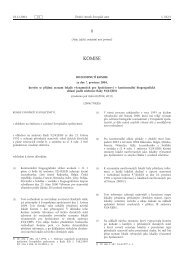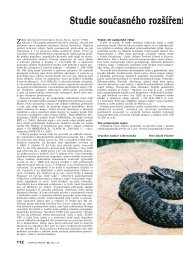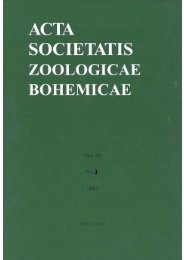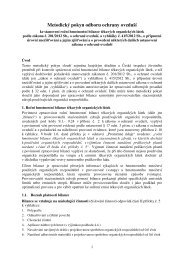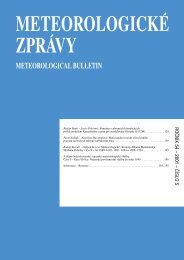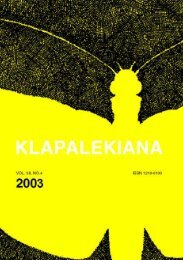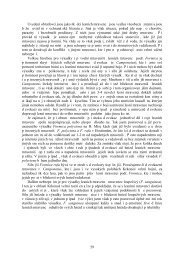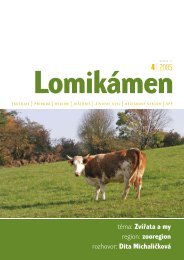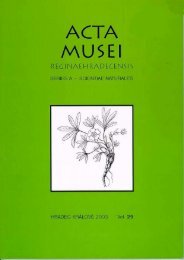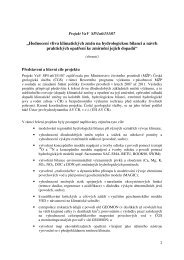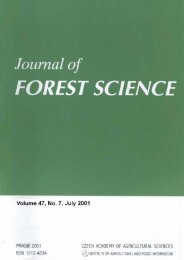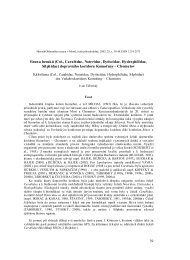Distribution and taxonomy of some Synapsis species, with ...
Distribution and taxonomy of some Synapsis species, with ...
Distribution and taxonomy of some Synapsis species, with ...
Create successful ePaper yourself
Turn your PDF publications into a flip-book with our unique Google optimized e-Paper software.
<strong>and</strong> also apterous S. carinata Herbst, 1783). However, based on the rich material studied from<br />
DEIC, JRUC, JSCC, MNHN <strong>and</strong> NMPC, these variations are not geographically based. Consequently,<br />
I consider Silpha venatoria Harold, 1877, Silpha perforata var. lateralis Portevin, 1926,<br />
Silpha perforata m<strong>and</strong>li Portevin, 1932 <strong>and</strong> Silpha perforata elongata Portevin, 1943 as junior<br />
subjective synonyms <strong>of</strong> Silpha perforata Gebler, 1832.<br />
Silpha puncticollis Lucas, 1846<br />
Silpha puncticollis Lucas, 1846: 213.<br />
Silpha puncticollis var. lucasi Portevin, 1926: 77; syn. n.<br />
COMMENTS. Silpha puncticollis is a widely distributed western Mediterranean <strong>species</strong> (Portevin<br />
1926, Pilo.a et al. 2002).<br />
Portevin (1926) described Silpha puncticollis var. lucasi, based on the fine punctation on<br />
pronotum <strong>and</strong> elytral intervals. Portevin (1926) did not publish a type locality, <strong>and</strong> probably did not<br />
formally label a type series. I have studied a series <strong>of</strong> 12 specimens from Algeria, Morocco <strong>and</strong><br />
Tunisia, <strong>with</strong> the h<strong>and</strong>-written label “var. Lucasi Port.” (probably by Portevin) in MNHN (coll.<br />
generale). In fact, the specimens do not distinctly differ in punctuation <strong>of</strong> dorsum from specimens,<br />
designated in the same collection (again, probably by Portevin) as the nominotypical form.<br />
Consequently, I consider Silpha puncticollis var. lucasi Portevin, 1926 as a junior subjective<br />
synonym <strong>of</strong> Silpha puncticollis Lucas, 1846.<br />
Silpha tyrolensis Laicharting, 1781<br />
Silpha tyrolensis Laicharting, 1781: 98.<br />
Silpha tyrolensis var. externa Portevin, 1926: 78; syn. n.<br />
Silpha tyrolensis cottia Depoli, 1931: 15; syn. n.<br />
Silpha tyrolensis pennina Depoli, 1931: 16; syn. n.<br />
Silpha tyrolensis var. pyrenaica Portevin, 1943: 48; syn. n.<br />
TYPE MATERIAL EXAMINED. HT female <strong>of</strong> Silpha tyrolensis var. pyrenaica (MNHN, coll. M. Pic / G. Portevin), labelled<br />
“For/t / d’Iraty [hw, by pencil] // var. pyrenaica m. / Type / ex coll. S t. Cl r. Deville [hw, Portevin’s MS] // TYPE<br />
[p, red label] // Museum Paris [p] // Silpha / tyrolensis / Laicharting, 1781 / Jan R%ži!ka det. 2002 [p]”.<br />
COMMENTS. Silpha tyrolensis is a mountainous <strong>species</strong>, distributed in western <strong>and</strong> central Europe<br />
(Portevin 1926, Horion 1949, Pilo.a et al. 2002).<br />
Portevin (1926) described Silpha tyrolensis var. externa <strong>with</strong>out giving a type locality; he<br />
probably did not formally label a type series. Portevin (1926) distinguished this variety based on<br />
its black colour <strong>and</strong> finer punctation <strong>of</strong> interstries on the elytra. I have studied a series <strong>of</strong> ten<br />
specimens from France <strong>and</strong> Germany, <strong>with</strong> the h<strong>and</strong>-written label “var. externa Port.” (probably by<br />
Portevin) deposited in MNHN (coll. M. Pic / G. Portevin). In my opinion, these specimens fall<br />
<strong>with</strong>in the individual variability <strong>of</strong> S. tyrolensis.<br />
Depoli (1931) described Silpha tyrolensis cottia from Italy: eastern Piemonte, based on an<br />
unknown number <strong>of</strong> dark brown specimens <strong>with</strong> coarser punctation <strong>of</strong> elytra <strong>and</strong> external costae<br />
curved at 3/4 <strong>of</strong> elytral length. According to personal communication from R. Fabbri <strong>and</strong> G. Burgio<br />
(curator <strong>of</strong> entomology at IEUS), no type specimen(s) <strong>of</strong> S. tyrolensis cottia were found in coll. G.<br />
Leoni, deposited in IEUS. In my opinion, differences given by Depoli (1931) concern only individual<br />
variation <strong>with</strong>in S. tyrolensis.<br />
Depoli (1931) described Silpha tyrolensis pennina from Italy: Gressoney, based on a series <strong>of</strong><br />
black specimens <strong>with</strong> external costae curved at 4/5 <strong>of</strong> elytral length. As in the previous taxon,<br />
315



